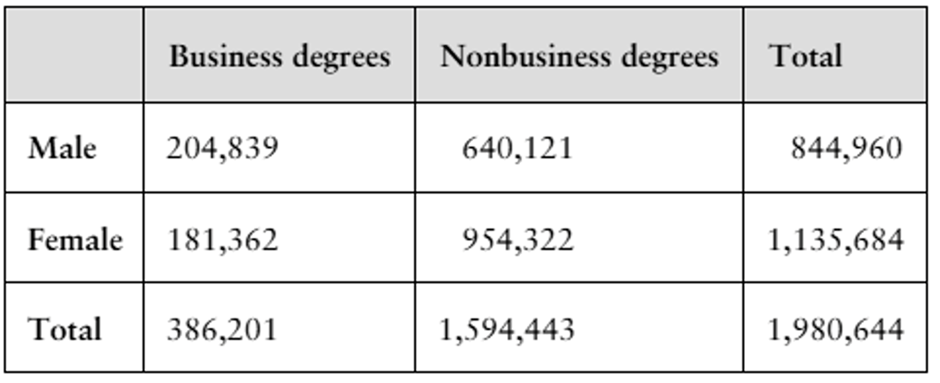The table below shows the results from a drug trial for a new ADHD medication. Use the table to find the probability that a person's symptoms improved, given that they received the placebo and identify the type of probability found.
Table of contents
- 1. Intro to Stats and Collecting Data1h 14m
- 2. Describing Data with Tables and Graphs1h 55m
- 3. Describing Data Numerically2h 5m
- 4. Probability2h 16m
- 5. Binomial Distribution & Discrete Random Variables3h 6m
- 6. Normal Distribution and Continuous Random Variables2h 11m
- 7. Sampling Distributions & Confidence Intervals: Mean3h 23m
- Sampling Distribution of the Sample Mean and Central Limit Theorem19m
- Distribution of Sample Mean - Excel23m
- Introduction to Confidence Intervals15m
- Confidence Intervals for Population Mean1h 18m
- Determining the Minimum Sample Size Required12m
- Finding Probabilities and T Critical Values - Excel28m
- Confidence Intervals for Population Means - Excel25m
- 8. Sampling Distributions & Confidence Intervals: Proportion1h 25m
- 9. Hypothesis Testing for One Sample3h 57m
- 10. Hypothesis Testing for Two Samples4h 50m
- Two Proportions1h 13m
- Two Proportions Hypothesis Test - Excel28m
- Two Means - Unknown, Unequal Variance1h 3m
- Two Means - Unknown Variances Hypothesis Test - Excel12m
- Two Means - Unknown, Equal Variance15m
- Two Means - Unknown, Equal Variances Hypothesis Test - Excel9m
- Two Means - Known Variance12m
- Two Means - Sigma Known Hypothesis Test - Excel21m
- Two Means - Matched Pairs (Dependent Samples)42m
- Matched Pairs Hypothesis Test - Excel12m
- 11. Correlation1h 24m
- 12. Regression1h 50m
- 13. Chi-Square Tests & Goodness of Fit2h 21m
- 14. ANOVA1h 57m
4. Probability
Introduction to Contingency Tables
Problem 3.2.7b
Textbook Question
Finding Conditional Probabilities In Exercises 7 and 8, use the table to find each conditional probability.
7. Business Degrees The table shows the numbers of male and female students in the United States who received bachelor's degrees in business and nonbusiness fields in a recent year. (Source: National Center for Educational Statistics)
b. Find the probability that a randomly selected bachelor's degree-earning student received a business degree, given that the student is female.

 Verified step by step guidance
Verified step by step guidance1
Step 1: Understand the problem. We are tasked with finding the conditional probability that a randomly selected bachelor's degree-earning student received a business degree, given that the student is female. Conditional probability is calculated using the formula P(A|B) = P(A ∩ B) / P(B), where A is the event of receiving a business degree and B is the event of being female.
Step 2: Identify the relevant values from the table. From the table, the number of female students who received business degrees is 181,362, and the total number of female students is 1,135,684.
Step 3: Calculate the numerator of the conditional probability formula, P(A ∩ B). This is the number of female students who received business degrees, which is 181,362.
Step 4: Calculate the denominator of the conditional probability formula, P(B). This is the total number of female students, which is 1,135,684.
Step 5: Divide the numerator by the denominator to find the conditional probability. The formula is P(A|B) = 181,362 / 1,135,684. Simplify the fraction to express the probability.
 Verified video answer for a similar problem:
Verified video answer for a similar problem:This video solution was recommended by our tutors as helpful for the problem above
Video duration:
4mPlay a video:
Was this helpful?
Key Concepts
Here are the essential concepts you must grasp in order to answer the question correctly.
Conditional Probability
Conditional probability refers to the likelihood of an event occurring given that another event has already occurred. It is denoted as P(A|B), which reads as the probability of event A occurring given that event B has occurred. This concept is crucial for understanding how probabilities can change based on additional information, such as knowing the gender of a student when determining the probability of them having a business degree.
Recommended video:

Conditional Probability Rule
Joint Probability
Joint probability is the probability of two events occurring simultaneously. In the context of the given question, it involves calculating the probability of a student being both female and having received a business degree. This concept is essential for understanding how to derive conditional probabilities from a dataset, as it helps in identifying the intersection of the two events being analyzed.
Recommended video:

Introduction to Probability
Marginal Probability
Marginal probability is the probability of a single event occurring without consideration of other events. It is calculated by summing the joint probabilities of the event across all possible outcomes. In this case, the marginal probability of a student being female can be found by summing the total number of female students, which is necessary for calculating the conditional probability of interest.
Recommended video:

Introduction to Probability

 5:35m
5:35mWatch next
Master Introduction to Contingency Tables with a bite sized video explanation from Patrick
Start learningRelated Videos
Related Practice
Multiple Choice
151
views
5
rank
